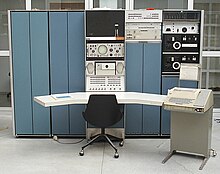PDP-7
 A modified PDP-7 under restoration in Oslo, Norway | |
| Manufacturer | Digital Equipment Corporation |
|---|---|
| Product family | Programmed Data Processor |
| Type | Minicomputer |
| Release date | 1965 |
| Introductory price | US$72,000 (equivalent to $696,127 in 2023) |
| Units sold | 120[1][2] |
| Units shipped | 120[2] |
| Operating system | DECsys, Unix (as "Unics") |
| Memory | 4K words (9.2 KB) (expandable up to 64K words (144 KB).)[1] |
| Storage | Paper-tape and dual transport DECtape drives (type 555) |
| Display | Printer |
| Input | Keyboard |
| Platform | DEC 18-bit |
| Backward compatibility | PDP-1 |
| Predecessor | PDP-4 |
| Successor | PDP-9 |


The PDP-7 is an 18-bit minicomputer produced by Digital Equipment Corporation as part of the PDP series. Introduced in 1964,[3]: p.8 [4] shipped since 1965, it was the first[5] to use their Flip-Chip technology. With a cost of US$72,000, it was cheap but powerful by the standards of the time. The PDP-7 is the third of Digital's 18-bit machines, with essentially the same instruction set architecture as the PDP-4 and the PDP-9.
Hardware
[edit]The PDP-7 was the first wire-wrapped PDP computer. The computer has a memory cycle time of 1.75 µs and an add time of 4 µs. Input/output (I/O) includes a keyboard, printer, punched tape and dual transport DECtape drives (type 555).[6] The standard core memory capacity is 4K words (9 KB) but expandable up to 64K words (144 KB).[1]
The PDP-7 weighs about 1,100 pounds (500 kg).[7]
Software
[edit]DECsys, the first operating system for DEC's 18-bit computer family (and DEC's first operating system for a computer smaller than its 36-bit timesharing systems), was introduced in 1965. It provides an interactive, single user, program development environment for Fortran and assembly language programs.[8]
In 1969, Ken Thompson wrote the first UNIX system, then named Unics as a pun on Multics despite only using two design elements from Multics,[9][10] in assembly language on a PDP-7,[11] as the operating system for Space Travel, a game which requires graphics to depict the motion of the planets. A PDP-7 was also the development system used during the development of MUMPS at MGH in Boston a few years earlier.
Sales
[edit]The PDP-7 was described as "highly successful."[12] A combined total of 120 of the PDP-7 and PDP-7A were sold.[3]: p.8 A DEC publication states that the first units shipped to customers in November 1964.
Eleven systems were shipped to the UK.[5]
Restorations
[edit]At least four PDP-7s were confirmed to still exist as of 2011[5] and a fifth was discovered in 2017.[13]
A PDP-7A (serial number 115) was under restoration in Oslo, Norway;[14] a second PDP-7A (serial number 113) previously located at the University of Oregon in its Nuclear Physics laboratory is now at the Living Computer Museum in Seattle, Washington and is completely restored to running condition after being disassembled for transport;[15] Another PDP-7 (serial number 47) is known to be in the collection of Max Burnet near Sydney, Australia, a fourth PDP-7 (serial number 33) is in storage at the Computer History Museum in Mountain View, California and a fifth PDP-7 (serial number 129) belonging to Fred Yerian is also located at the Museum, and has been demonstrated running Unix version 0 and compiling a B program.[13]
References
[edit]- ^ a b c "PDP-7 Definition". The Linux Information Project. September 27, 2007.
- ^ a b "1964 — PDP-7". DIGITAL Computing Timeline – via Microsoft.
Ultimately, 120 PDP-7s were produced and sold.
- ^ a b "Digital Equipment Corporation - 1957 to the present" (PDF). Archived (PDF) from the original on October 9, 2022.
- ^ "across the editor's desk: COMPUTING AND DATA PROCESSING NEWSLETTER - PDP-7 ANNOUNCED BY DIGITAL" (PDF). Computers and Automation. XIII (7): 45. July 1964. Archived (PDF) from the original on October 9, 2022. Retrieved September 5, 2020.
- ^ a b c Tore Sinding Bekkedal (2009). "Digital Equipment Corporation PDP-7". soemtron.org.
- ^ "Pdp-7". reference.com Computing Dictionary. Archived from the original on June 16, 2013.
- ^ "PDP-7 documents". www.bitsavers.org. PDP-7_Maint.pdf, p. 1-14 (32).
- ^ Supnik, Bob (June 19, 2006). "Technical Notes on DECsys" (PDF). Archived (PDF) from the original on October 9, 2022.
- ^ Ritchie, Dennis M. (1977). The Unix Time-sharing System: A retrospective (PDF). Tenth Hawaii International Conference on the System Sciences. Archived (PDF) from the original on October 9, 2022.
a good case can be made that UNIX is in essence a modern implementation of MIT's CTSS system
- ^ Seibel, Peter (2009). Coders at work : reflections on the craft of programming. New York: Apress. p. 463. ISBN 9781430219491.
The things that I [Ken Thompson] liked [about Multics] enough to actually take were the hierarchical file system and the shell
- ^ Ritchie, Dennis M. "The Development of the C Language".
- ^ "DEC PDP-9, System Number 319". Rhode Island Computer Museum.
- ^ a b "Restoring UNIX v0 on a PDP-7: A look behind the scenes". Retrieved November 18, 2019.
- ^ "Picture album of PDP-7 restoration project". Archived from the original on July 15, 2012. Retrieved June 24, 2005. PDP-7 restoration project located in Oslo, Norway.
- ^ "Colloquium Details - The University's 40 year old PDP-7 computer is alive again in Seattle". Archived from the original on March 14, 2012. Retrieved March 2, 2011. University of Oregon's PDP-7 moves to the Living Computer Museum in Seattle, Washington. Alternate host at https://www.soemtron.org/pdp7no113systeminfo.html "January 2011" section.
External links
[edit]- Information about the PDP-7 and PDP-7/A, including some manuals and a customer list covering 99 of the systems shipped, Digital Equipment Corporation PDP-7.
- "The famous PDP-7 comes to the rescue" (Bell Labs' Unix history) at the Wayback Machine (archived April 2, 2014)
